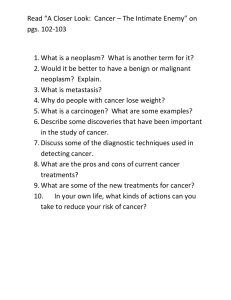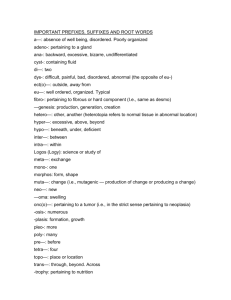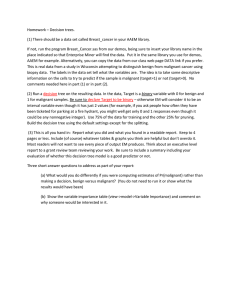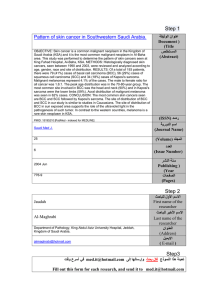Chapter 8
advertisement
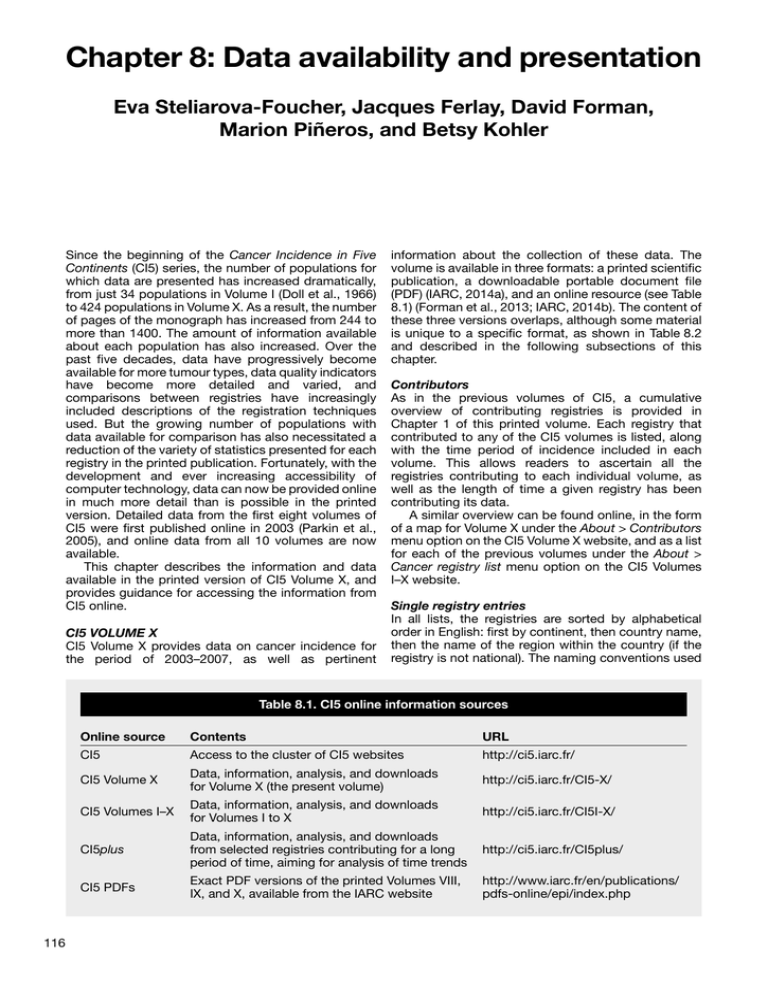
Chapter 8: Data availability and presentation Eva Steliarova-Foucher, Jacques Ferlay, David Forman, Marion Piñeros, and Betsy Kohler Since the beginning of the Cancer Incidence in Five Continents (CI5) series, the number of populations for which data are presented has increased dramatically, from just 34 populations in Volume I (Doll et al., 1966) to 424 populations in Volume X. As a result, the number of pages of the monograph has increased from 244 to more than 1400. The amount of information available about each population has also increased. Over the past five decades, data have progressively become available for more tumour types, data quality indicators have become more detailed and varied, and comparisons between registries have increasingly included descriptions of the registration techniques used. But the growing number of populations with data available for comparison has also necessitated a reduction of the variety of statistics presented for each registry in the printed publication. Fortunately, with the development and ever increasing accessibility of computer technology, data can now be provided online in much more detail than is possible in the printed version. Detailed data from the first eight volumes of CI5 were first published online in 2003 (Parkin et al., 2005), and online data from all 10 volumes are now available. This chapter describes the information and data available in the printed version of CI5 Volume X, and provides guidance for accessing the information from CI5 online. CI5 Volume X CI5 Volume X provides data on cancer incidence for the period of 2003–2007, as well as pertinent information about the collection of these data. The volume is available in three formats: a printed scientific publication, a downloadable portable document file (PDF) (IARC, 2014a), and an online resource (see Table 8.1) (Forman et al., 2013; IARC, 2014b). The content of these three versions overlaps, although some material is unique to a specific format, as shown in Table 8.2 and described in the following subsections of this chapter. Contributors As in the previous volumes of CI5, a cumulative overview of contributing registries is provided in Chapter 1 of this printed volume. Each registry that contributed to any of the CI5 volumes is listed, along with the time period of incidence included in each volume. This allows readers to ascertain all the registries contributing to each individual volume, as well as the length of time a given registry has been contributing its data. A similar overview can be found online, in the form of a map for Volume X under the About > Contributors menu option on the CI5 Volume X website, and as a list for each of the previous volumes under the About > Cancer registry list menu option on the CI5 Volumes I–X website. Single registry entries In all lists, the registries are sorted by alphabetical order in English: first by continent, then country name, then the name of the region within the country (if the registry is not national). The naming conventions used Table 8.1. CI5 online information sources 116 Online source Contents URL CI5 Access to the cluster of CI5 websites http://ci5.iarc.fr/ CI5 Volume X Data, information, analysis, and downloads for Volume X (the present volume) http://ci5.iarc.fr/CI5-X/ CI5 Volumes I–X Data, information, analysis, and downloads for Volumes I to X http://ci5.iarc.fr/CI5I-X/ CI5plus Data, information, analysis, and downloads from selected registries contributing for a long period of time, aiming for analysis of time trends http://ci5.iarc.fr/CI5plus/ CI5 PDFs Exact PDF versions of the printed Volumes VIII, IX, and X, available from the IARC website http://www.iarc.fr/en/publications/ pdfs-online/epi/index.php Data availability and presentation Table 8.2. Data available in CI5 Volume X and the online publications of the CI5 series Online publications X X Volume (print) IX VIII VII VI V IV III II I CI5plus ✓ ✓ ✓ ✓ ✓ ✓ ✓ ✓ ✓ ✓ ✓ Baseline information and data List of contributors ✓ Registry-specific texts ✓ Sex-specific registry population pyramids ✓ Top-10 cancers table ✓ Techniques of registration (registry-specific) ✓ Data quality indices ✓ ✓ ✓ ✓ ✓ ✓ ✓ List of tumour categories ✓ ✓ ✓ ✓ ✓ ✓ ✓ ✓ ✓ ✓ ✓ ✓ Comparative tables by three-digit ICD ✓ ✓ Comparative tables by four-digit ICD ✓ Comparative tables by histological group ✓ Online analysis Production of tables Tabulated age-specific rates ✓ ✓ ✓ ✓ ✓ ✓ ✓ ✓ ✓ ✓ ✓ Sex-specific registry population pyramids ✓ ✓ ✓ ✓ ✓ ✓ ✓ ✓ ✓ ✓ ✓ Tabulated rates compared across registries ✓ ✓ ✓ ✓ ✓ ✓ ✓ ✓ ✓ ✓ ✓ Tabulated rates compared across tumour sites ✓ ✓ ✓ ✓ ✓ ✓ ✓ ✓ ✓ ✓ ✓ Tabulated rates compared across CI5 volumes ✓ Tabulated rates compared across calendar years ✓ Production of graphs, numbers, and statistics Age-specific rates ✓ ✓ Incidence time trends for a single age range ✓ ✓ Incidence time trends for selected age groups ✓ ✓ Incidence time trends for birth cohorts ✓ Population pyramids ✓ Export of the results ✓ ✓ Specific analytical software (Windows-based) ✓ ✓ ✓ ✓ ✓ ✓ ✓ ✓ ✓ ✓ ✓ Downloads PDF version of the printed publication ✓ ✓ ✓ • plus registry-sex-age-specific incidence tables ✓ ✓ ✓ • plus comparative tables by four-digit ICD ✓ ✓ ✓ • plus comparative tables by histological group ✓ ✓ ✓ ✓ ✓ ✓ Tabulated data from the printed volume in comma-separated values (CSV) format ✓ Tabulated data from the online application Detailed aggregated data (> 240 tumour entities) Detailed aggregated data (181 tumour entities) ✓ ✓ ✓ ✓ ✓ ✓ ✓ 117 Data availability and presentation for the geographical entities were guided by the United Nations standards (United Nations, 2012). Each population label includes the name of the country, the name of the region (if applicable), the name of the subpopulation (such as racial or ethnic group, if applicable), and the time period of data contribution. Registry-specific entries constitute the largest section, of approximately 800 pages, located in the middle of the printed publication. Narratives Each contributing registry provided a short text (limited to 350 words) describing the registration area, the population covered, the cancer care facilities, the data acquisition and processing techniques, the source(s) of population data, and other information useful for interpreting the data. Publications providing further details are also cited in this section. The narratives are included in this printed volume, and can also be downloaded as a component of the PDF version of the publication. Population pyramids For each population defined by a registry, a population pyramid is provided, showing the average annual person-years at risk during the reference period, for males and females, in 5-year age groups. The number of age groups depends on the age distribution of the population data provided. The horizontal bars of the pyramids represent the percentage contribution of each sex–age group to the total population. References to the population sources are provided. The population pyramids are presented in this printed volume, and are also included in the registry summary tables available for download online. Cancer data Based on the submitted data, the registry narratives are supplemented with tables showing the sex-specific age-standardized rates per 100 000 population observed in each registry area during the reference period for the 10 most common cancers, and for all sites combined. In addition, a one-page overview table per population presents sex-specific statistics for all ages: the total number of cases, the percentage contribution of each cancer site to the total, and the incidence rates (crude and standardized rates per 100 000, and cumulative rates for the age ranges 0–64 and 0–74 years, expressed as percentages). The standardization is based on the world standard population (Segi, 1960), and the methods used are described in Chapter 7 of this volume. The cancer sites are arranged in ascending order of ICD-10 codes, which are displayed along with the site labels. Where applicable, these tables are provided for each subpopulation defined by the registry. Detailed population-specific data are available exclusively online, under the heading Tables (PDF) > Registry summary tables on the CI5 Volume X website. In addition to the population pyramid and the onepage overview table described above, sex-agespecific incidence rates for 63 cancer sites, defined in Chapter 3, and the two combined totals of all cancers 118 (including and excluding non-melanoma cancers of the skin) are tabulated on two pages, one for each sex. In addition to the statistics described above, these detailed tables include the numbers of cases with unknown age (if any) and the age-specific incidence rates for up to 18 age groups. Asterisks The entries for some registries or populations are marked by an asterisk preceding the registry label. This asterisk indicates that data comparability may be reduced for the reasons listed under the heading “Notes on the data” within the registry narrative. The procedure leading to such a designation is described in full in Chapter 5. Comparative cancer incidence tables The comparative incidence tables show incidence data for a single group of neoplasms across all populations included in the volume. Each comparative incidence table is sex-specific and spreads across four pages, listing the included populations vertically. There are three types of comparative cancer incidence table, differing by the definition of the presented neoplasms. Each set of tables is arranged in ascending order of ICD-10 codes; showing the aggregated totals first. Summary tables by site (ICD-10 three-digit rubrics): The first set of tables shows all cancers combined (including and excluding non-melanoma skin cancers), the 63 three-digit (ICD-10) cancer sites described in Chapter 3, and the two grouped categories “Colorectal” and “Leukaemia”. Each table for these categories shows sex-specific data for all ages combined, including the number of cases, the agestandardized incidence rate (using the world standard population), and the cumulative incidence rate for the age range 0–74 years. The rates are accompanied by their standard errors. As in the registry-specific tables, an asterisk preceding the registry label refers to the relevant registry-specific notes provided on the corresponding registry narrative page. These comparative tables run from page 918 to 1252 of the printed book, under the title Age-standardized and cumulative incidence rates and standard errors, and they are also available online under the heading Tables (PDF) > Tables by site (3-digit category) on the CI5 Volume X website. Chapter 3 provides an overview of the usage of international classifications (WHO, 1977; WHO, 1992; WHO, 1976; Percy et al., 1990; Fritz et al., 2000) for coding reported cancer diagnoses in cancer registries, as well as the inclusion rules of selected non-malignant neoplasms reportable by the contributing registries. Summary tables by site (ICD-10 four-digit rubrics): The second set of tables has the same structure as the first, and shows data for detailed site categories (WHO, 1992), as listed in Table 8.3 at the end of this chapter. These categories can only be found online, and are accessible under the heading Tables (PDF) > Tables by site (4-digit category) on the CI5 Volume X website. Summary tables by histological type: The third set of comparative tables shows data for histological Data availability and presentation type groups for 15 selected cancer sites. These sexspecific tables list the total number of cases, the number of cases that were microscopically verified, and the age-standardized incidence rates for each defined histological group. Chapter 4 describes how the 15 selected cancer sites were divided into relevant histological type groups. These tables can be found online under the heading Tables (PDF) > Tables by histological type on the CI5 Volume X website. Comparison of registration practices Each submitting cancer registry completed a questionnaire describing their registration practices during the reference period of 2003–2007, as described in Chapter 2. The tabulated data include registry location, size of the population covered, year data collection began, reporting rules, data sources, data items recorded, and follow-up for vital status. These data are available online on the CI5 Volume X website under the Techniques of registration heading in two tables: Registry background and Case finding and abstracting. This information helps in the interpretation of the observed patterns of cancer incidence. Indices of quality and comparability All submitted datasets were subjected to computerized records checks and editorial review. The decision as to whether to include a given dataset in Volume X was largely based on the data quality indicators, such as percentage of microscopically verified diagnoses, percentage of cases reported from death certificates only, mortality-to-incidence ratios, age-specific and temporal distribution of cases, and other factors, as described in Chapter 5. Some of the data quality indicators are tabulated in Chapter 5 (e.g. the presence of active screening programmes). Other indicators are presented systematically for all registries in the sitespecific tables titled Indices of data quality located at the end of the printed volume. The tables can also be found online under the Tables (PDF) > Indices of data quality menu option on the CI5 Volume X website. These tables were generated for 22 selected major sites or groups of cancer sites, as well as for the total of all sites combined. The indicators shown, for each sex, include number of cases, percentage of microscopically verified diagnoses [MV(%)], percentage of cases registered on the basis of death certificate only [DCO(%)], and mortality-to-incidence ratio [MI(%)] – the ratio of the number of cancer deaths to the number of cancer cases. Online analysis The CI5 Volume X website includes a heading for Online analysis routines, which can produce three types of output. The Table by cancers option lets users create a table showing the number of cases and the crude, age-standardized, and cumulative rates for each of the defined ICD-10 cancer sites, for a selected sex and age range (within the 18 five-year age groups) and a selected population or combination of populations. The results can be sorted by ICD-10 category or by any of the provided statistics. The Table by populations option lets users create a table showing the above-listed statistics for a single cancer site or a combination of cancer sites, for all populations included in Volume X or for the choice of continent(s) indicated by the user. The entire table is sex-specific, and users can restrict the age range and sort the results. The Age-specific curves option can provide up to 12 age-specific curves for a given population or combination of populations, tumour site or group of tumour sites, age range, and sex. Users can specify a title for the output graph (if more than one population or cancer is grouped), the line style, and other options. The underlying data used to generate the tables and graphs can be exported as comma-separated values (CSV) files. CI5 Volumes I to X online The data of all 10 CI5 volumes are available online at http://ci5.iarc.fr/CI5I-X/. Under the About tab, the website provides an overview of the contributing cancer registries through the Cancer registry list menu option, an equivalence table of the cancer sites used in different periods through the Cancer dictionary option, Notes specific to the individual volumes, and other relevant information. Under the Indices of data quality tab, indices of data quality are tabulated for Volumes V to X according to principles similar to those already described for Volume X. The Online analysis tab provides options for users to analyse the data published in all CI5 volumes, with outputs similar to those described for the specific CI5 Volume X website. One exception is age-specific data, which are displayed in the form of a table rather than a graph. Additionally, assessment of temporal trends is possible using the Standardized rates by > Volumes option, whereby the numbers of cases and incidence rates from all CI5 volumes can be tabulated for a selected cancer site, population, sex, and age range. The data from all generated tables can be exported to standard CSV files. CI5plus software CI5plus (Ferlay et al., 2014) provides online software to help users explore cancer incidence trends for registries that were included in at least three consecutive volumes of CI5, including Volume X. CI5plus contains updated annual incidence rates for 118 selected populations from 102 cancer registries published in CI5, for the longest period available (up to 2007), for all cancers and 27 major types. CI5plus should be used in conjunction with the original CI5 publications, because differences over time in registration practices and changes in coding may influence the interpretation of the incidence time trends. A full description of this online system is provided in the publication accompanying the first release of CI5plus (Parkin et al., 2005). Citing CI5 sources A new CI5 volume is published approximately every 5 years by the International Agency for Research on Cancer (IARC) in collaboration with the International Association of Cancer Registries (IACR). Each volume provides comparable high-quality cancer incidence data in the countries or regions where they are 119 Data availability and presentation collected. These data provide a baseline for generating knowledge of cancer causes and control. The online publication of the data enables any interested user to compare cancer rates across diverse populations. CI5 is the fruit of collaboration among thousands of people worldwide over more than five decades. Its collaborators strive for common standards and a common cause. Without their hard work and dedication, this information would simply not be available. The only reward expected by the CI5 collaborators is the acknowledgement of their efforts through the appropriate citation of these unique resources by all users, as shown in the following examples: Printed or PDF copy of Volume X General reference Forman D, Bray F, Brewster DH, Gombe Mbalawa C, Kohler B, Piñeros M, Steliarova-Foucher E, Swaminathan R, Ferlay J, editors (2014). Cancer Incidence in Five Continents, Vol. X. IARC Scientific Publication No. 164. Lyon: International Agency for Research on Cancer. Reference to the material related to an individual registry North AB, South CD (2014). Cancer incidence in Antarctica (2003–2007). In: Forman D, Bray F, Brewster DH, Gombe Mbalawa C, Kohler B, Piñeros M, Steliarova-Foucher E, Swaminathan R, Ferlay J, editors. Cancer Incidence in Five Continents, Vol. X. IARC Scientific Publication No. 164. Lyon: International Agency for Research on Cancer. Reference to an introductory chapter Forman D, Brewster DH, Kohler B, Piñeros M (2014). Chapter 1: Introduction. In: Forman D, Bray F, Brewster DH, Gombe Mbalawa C, Kohler B, Piñeros M, Steliarova-Foucher E, Swaminathan R, Ferlay J, editors. Cancer Incidence in Five Continents, Vol. X. IARC Scientific Publication No. 164. Lyon: International Agency for Research on Cancer. References Doll R, Payne P, Waterhouse J, editors (1966). Cancer Incidence in Five Continents: A Technical Report. Berlin: Springer-Verlag (for UICC). Ferlay J, Bray F, Steliarova-Foucher E, Forman D (2014). Cancer Incidence in Five Continents, CI5plus. IARC CancerBase No. 9. Lyon: International Agency for Research on Cancer. Available from: http://ci5.iarc.fr. Forman D, Bray F, Brewster DH, Gombe Mbalawa C, Kohler B, Piñeros M, et al., editors (2013). Cancer Incidence in Five Continents, Vol. X (electronic version). Lyon: International Agency for Research on Cancer. Available from: http://ci5.iarc.fr, accessed 2 June 2014. Fritz A, Percy CL, Jack A, Shanmugaratnam K, Sobin L, Parkin DM, et al., editors (2000). International Classification of Diseases for Oncology. 3rd ed. (ICD-O-3). Geneva: World Health Organization. 120 Online version of Volume X General reference Forman D, Bray F, Brewster DH, Gombe Mbalawa C, Kohler B, Piñeros M, Steliarova-Foucher E, Swaminathan R, Ferlay J, editors (2013). Cancer Incidence in Five Continents, Vol. X (electronic version). Lyon: International Agency for Research on Cancer. Available from: http://ci5.iarc.fr, accessed [date]. Reference to an individual registry North AB, South CD (2013). Cancer incidence in Antarctica (2003–2007). In: Forman D, Bray F, Brewster DH, Gombe Mbalawa C, Kohler B, Piñeros M, Steliarova-Foucher E, Swaminathan R, Ferlay J, editors. Cancer Incidence in Five Continents, Vol. X (electronic version). Lyon: International Agency for Research on Cancer. Available from: http://ci5.iarc.fr, accessed [date]. Volumes I to X (online application) Reference to data extracted from the analysis menu options IARC (2014). Cancer Incidence in Five Continents, Vol. I–X (electronic version). Lyon: International Agency for Research on Cancer. Available from: http://ci5.iarc.fr/ CI5I-X/Default.aspx, accessed [date]. Reference to data from individual volumes See individual volume listings at http://ci5.iarc.fr/ CI5I-X/Pages/references.aspx. CI5plus Ferlay J, Bray F, Steliarova-Foucher E, Forman D (2014). Cancer Incidence in Five Continents, CI5plus. IARC CancerBase No. 9. Lyon: International Agency for Research on Cancer. Available from: http://ci5.iarc.fr, accessed [date]. IARC (2014a). IARC Publications, PDFs online, Cancer Epidemiology. Lyon: International Agency for Cancer Research. Available from: http://www.iarc. fr/en/publications/pdfs-online/epi/index.php, accessed 6 May 2014. IARC (2014b). Cancer Incidence in Five Continents, Vol. I–X (electronic version). Lyon: International Agency for Research on Cancer. Available from: http://ci5.iarc.fr/CI5I-X/Default.aspx, accessed 2 June 2014. Parkin DM, Whelan SL, Ferlay J, Storm H (2005). Cancer Incidence in Five Continents, Vol. I–VIII. IARC CancerBase No. 7. Lyon: International Agency for Research on Cancer. Percy CL, Van Holten V, Muir CS, editors (1990). International Classification of Diseases for Oncology. 2nd ed. (ICD-O-2). Geneva: World Health Organization. Data availability and presentation Segi M (1960). Cancer mortality for selected sites in 24 countries (1950–57). Sendai, Japan: Department of Public Health, Tohoku University School of Medicine. United Nations Department of Economic and Social Affairs (2012). Composition of macro geographical (continental) regions, geographical sub-regions, and selected economic and other groupings. Available from: http://unstats.un.org/unsd/methods/ m49/m49regin.htm, accessed 2 June 2014. WHO (1976). International Classification of Diseases for Oncology. 1st ed. (ICD-O-1). Geneva: World Health Organization. WHO (1977). International Classification of Diseases. 1975 revision (ICD-9). Geneva: World Health Organization. WHO (1992). International Statistical Classification of Diseases and Related Health Problems. 10th revision (ICD-10). Geneva: World Health Organization. Table 8.3. ICD-10 categories used for the online display of the detailed site comparative tables ICD-10 code Short title used in tables Full title C01 Base of tongue Malignant neoplasm of base of tongue C02 Other parts Malignant neoplasm of other and unspecified parts of tongue C03 Gum Malignant neoplasm of gum C04 Floor of mouth Malignant neoplasm of floor of mouth C05 Palate Malignant neoplasm of palate C06 Other parts Malignant neoplasm of other and unspecified parts of mouth C07 Parotid Malignant neoplasm of parotid gland C08.0 Submandibular Malignant neoplasm of submandibular gland C08.1 Sublingual Malignant neoplasm of sublingual gland C08.8–9 Other & unspec. Overlapping lesion of major salivary glands, major salivary glands, unspecified C12 Piriform sinus Malignant neoplasm of piriform sinus C13 Other & unspec. Malignant neoplasm of hypopharynx C15.0,3 Upper third Malignant neoplasm of cervical part/upper third of oesophagus C15.1,4 Middle third Malignant neoplasm of thoracic part/middle third of oesophagus C15.2,5 Lower third Malignant neoplasm of abdominal part/lower third of oesophagus C15.8–9 Other & unspec. Overlapping lesion of oesophagus, oesophagus, unspecified C16.0 Cardia Malignant neoplasm of cardia C16.1 Fundus Malignant neoplasm of fundus of stomach C16.2 Body Malignant neoplasm of body of stomach C16.3 Pyloric Malignant neoplasm of pyloric antrum C16.4 Pylorus Malignant neoplasm of pylorus C16.5 Le. curv. Malignant neoplasm of lesser curvature of stomach, unspecified C16.6 Gr. curv. Malignant neoplasm of greater curvature of stomach, unspecified C16.8–9 Other & unspec. Overlapping lesion of stomach, stomach, unspecified C18.0 Caecum Malignant neoplasm of caecum C18.1 Appendix Malignant neoplasm of appendix C18.2 Ascend. Malignant neoplasm of ascending colon C18.3 Hepatic Malignant neoplasm of hepatic flexure C18.4 Transv. Malignant neoplasm of transverse colon C18.5 Splenic Malignant neoplasm of splenic flexure C18.6 Descend. Malignant neoplasm of descending colon 121 Data availability and presentation Table 8.3. (Contd) ICD-10 categories used for the online display of the detailed site comparative tables ICD-10 code Short title used in tables Full title C18.7 Sigmoid Malignant neoplasm of sigmoid colon C18.8–9 Other Overlapping lesion of colon, colon, unspecified C19 Rectosigmoid junction Malignant neoplasm of rectosigmoid junction C20 Rectum Malignant neoplasm of rectum C21.0–2 Anus Malignant neoplasm of anus, anal canal and cloacogenic zone C21.8 Anorectum Overlapping lesion of rectum, anus and anal canal C23 Gallbladder Malignant neoplasm of gallbladder C24.0 Extrahepatic duct Malignant neoplasm of extrahepatic bile duct C24.1 Ampulla of Vater Malignant neoplasm of ampulla of Vater C24.8–9 Other & unspec. Overlapping lesion of biliary tract, biliary tract, unspecified C30.0 Nasal cavity Malignant neoplasm of nasal cavity C30.1 Middle ear Malignant neoplasm of middle ear C31.0 Maxillary sinus Malignant neoplasm of maxillary sinus C31.1–3 Other sinuses Malignant neoplasm of other parts of sinuses C31.8–9 Overlap. & unspec. Overlapping lesion of accessory sinuses, accessory sinuses, unspecified C33 Trachea Malignant neoplasm of trachea C34.0 Main bronchus Malignant neoplasm of main bronchus C34.1 Upper lobe Malignant neoplasm of upper lobe, bronchus or lung C34.2 Middle lobe Malignant neoplasm of middle lobe, bronchus or lung C34.3 Lower lobe Malignant neoplasm of lower lobe, bronchus or lung C34.8–9 Other & unspec. Overlapping lesion of bronchus and lung, bronchus and lung, unspecified C37 Thymus Malignant neoplasm of thymus C38.0 Heart Malignant neoplasm of heart C38.1–3 Mediastinum Malignant neoplasm of mediastinum C38.4 Pleura Malignant neoplasm of pleura C38.8 Overlapping Overlapping lesion of heart, mediastinum and pleura C40.0 Upper, long Malignant neoplasm of scapula and long bones of upper limb C40.1 Upper, short Malignant neoplasm of short bones of upper limb C40.2 Lower, long Malignant neoplasm of long bones of lower limb C40.3 Lower, short Malignant neoplasm of short bones of lower limb C40.8–9 Other & unspec. Overlapping lesion of bone and articular cartilage of limbs, bone and articular cartilage of limb, unspecified C41.0 Skull & face Malignant neoplasm of bones of skull and face C41.1 Mandible Malignant neoplasm of mandible C41.2 Vertebral column Malignant neoplasm of vertebral column C41.3 Ribs etc. Malignant neoplasm of ribs, sternum and clavicle C41.4 Pelvic bones Malignant neoplasm of pelvic bones, sacrum and coccyx Other & unspec. Overlapping lesion of bone and articular cartilage, bone and articular cartilage, unspecified C41.8–9 122 Data availability and presentation Table 8.3. (Contd) ICD-10 categories used for the online display of the detailed site comparative tables ICD-10 code Short title used in tables Full title C43.0–4 Head Malignant melanoma of lip, eyelid, ear and external auricular canal, face and scalp and neck C43.5 Trunk Malignant melanoma of trunk C43.6 Upper limb Malignant melanoma of upper limb, including shoulder C43.7 Lower limb Malignant melanoma of lower limb, including hip C43.8 Overlapping Overlapping malignant melanoma of skin C43.9 Unspecified Malignant melanoma of skin, unspecified C46.0 Skin Kaposi sarcoma of skin C46.1 Soft tissue Kaposi sarcoma of soft tissue C46.2 Palate Kaposi sarcoma of palate C46.3 Lymph nodes Kaposi sarcoma of lymph nodes C46.7 Other Kaposi sarcoma of other sites C46.8 Multiple Kaposi sarcoma of multiple organs C46.9 Unspecified Kaposi sarcoma, unspecified C47 Peripheral nerves Malignant neoplasm of peripheral nerves and autonomic nervous system C49 Connective and soft tissue Malignant neoplasm of other connective and soft tissue C57.0 Fallopian tube Malignant neoplasm of fallopian tube C57.1–4 Uterine adnexa Malignant neoplasm of broad and round ligaments, parametrium and uterine adnexa, unspecified C57.7 Other specified Malignant neoplasm of other specified female genital organs C57.8–9 Overlap. & unspec. Overlapping lesion of female genital organs, female genital organ, unspecified C70 Meninges Malignant neoplasm of meninges C71 Brain Malignant neoplasm of brain C72.0–5 Cranial nerves Malignant neoplasm of spinal cord and other and unspecified cranial nerves C72.8–9 Other & unspecified Overlapping lesion of brain and other parts of central nervous system, central nervous system, unspecified 123
